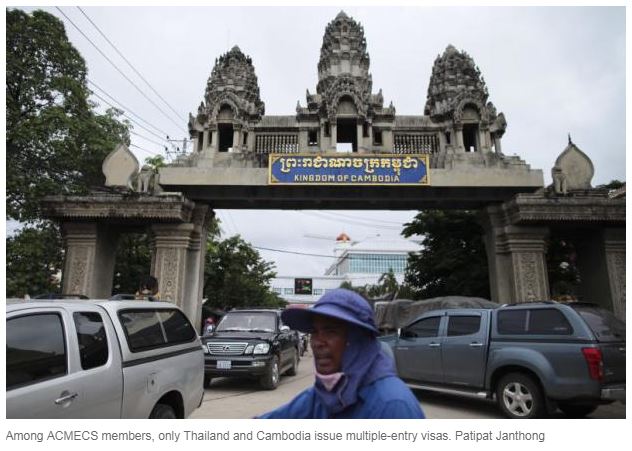ACMECS meeting aims for strengthened ties
The Ayeyawady-Chao Phraya-Mekong Economic Cooperation Strategy (ACMECS) aims to strengthen ties between countries in the Mekong Delta by reducing economic barriers to cooperation.
The scheme, to be presented in a forum in Bangkok this weekend, will promote the adoption of multiple-entry visas and establishing a common infrastructure fund, said Sanan Angubolkul, chairman of the ACMECS Business Council and president of the Thailand-Vietnam Business Council.
The Bangkok Post sat down with Mr Sanan to discuss the details of the initiative and what policymakers and businessmen can expect from the forum.
What is ACMECS?
ACMECS, established in April 2003, is a cooperation framework among Cambodia, Laos, Myanmar, Thailand and Vietnam to utilise member countries’ diverse strengths and promote balanced development in the subregion.
ACMECS will act as a catalyst to build upon existing regional cooperation programmes and complement bilateral frameworks with a view to transforming the border areas of the five countries into zones of economic growth, driving social progress and prosperity.
The scheme is further targeted to blend local, national and regional interests for common benefits, shared prosperity, enhanced solidarity, peace, stability and good neighbourliness.
Can you expand on the objectives of the cooperation framework?
ACMECS is a platform bridging the economic gaps among the five countries, generating greater growth and increasing competitiveness along their borders. ACMECS will facilitate the relocation of agricultural and manufacturing industries to areas with comparative advantages. It will create employment opportunities and value for Asean.
What are some of the activities of ACMECS?
ACMECS is a project framework which covers six areas of cooperation: trade and investment facilitation, agricultural and industrial cooperation, transport linkages, tourism cooperation, human resource development and public health.
What is the theme of ACMECS’s 2018 forum?
This year, Thailand will host the 8th ACMECS Summit on June 15 and 16 in Bangkok under the theme “Towards an Integrated and Connected Mekong Community”.
On June 15, ACMECS will hold a CEO forum under the theme “Connecting our Future: Enhancing ACMECS Cooperation and Integration” as a platform for the leaders and representatives from the public and private sectors to network and exchange their views on trade and investment.
How many people will participate in this forum?
ACMECS forum is a cooperation framework between the government and leading business sectors from the five countries. More than 200 leaders were invited to the ACMECS forum.
ACMECS also invited governments and members of the business sector from non-ACMECS countries like China and Japan, both of which are major investors in ACMECS countries and Asean.
What’s are the highlights of this year’s forum?
ACMECS’s overarching aim is to promote the creation of a single production base in the ACMECS countries, particularly along the border areas, that will support the greater Asean Economic Community (AEC) as well as enhance trade, investment and transport.
Talks at the forum will centre on this subject. The forum will deal with the ACMECS Infrastructure Fund and Trust, a project fund open to ACMECS member countries that we hope to implement this year. The ACMECS Infrastructure Fund and Trust are possible modalities of funding for projects in the ACMECS master plan (2019-23).
This summit will adopt a Bangkok Declaration, which will underline the commitment of member countries to achieve sustainable cooperation that will achieve tangible outcomes. It will also adopt the ACMECS master plan, which focuses on seamless connectivity, along with a synchronised, smart and sustainable ACMECS, and will be used as a roadmap to enhance cooperation among members, as well as to engage future development partners.
What topics will the business sector discuss at the forum?
Business leaders from the lower Mekong region will urge their respective governments to use local currencies for trading in border regions to facilitate business transactions and reduce exchange costs. Business leaders will push forward the use of local currencies to trade in border areas, a move that will benefit business operators, ease trade processes and reduce the risks and costs of volatile exchange rates against the US dollar.
It will also propose the use of multiple-entry visas to facilitate international visits to CLMV countries. At present, Thailand and Cambodia use multiple-entry visas.
CLMV is the rising star of tourism in Asean, while Thailand is already an established destination and the centre of the region. CLMV countries want to benefit from this international tourism inflow by cooperating with Thailand, which has more than 30 million visitors per year.
Lastly, the business sector will propose the establishment of a single-stop investigating (SSI) centre at checkpoints along the border to facilitate terrestrial transfers of goods between Asean countries.
How will ACMECS link to other business frameworks?
The master plan focuses on connectivity along the East West Economic Corridor (EWEC) and the Southern Economic Corridor (SEC). In the case of Thailand, the scheme will also complement the government’s EEC, new S-curve and Thailand 4.0 projects.
The master plan will also be used as the roadmap to cooperate among members, especially in the fields of system and rules connectivity, and sustainable and innovative development of the subregions, making CLMVT a nucleus of growth that will enhance Asean integration.
What should we expect for the GDP of ACMECS countries?
Last year, CLMVT had a total GDP of US$760.17 billion (24.5 trillion baht), with Thailand contributing $437.8 billion, Cambodia $22.25 billion, Laos copy7.15 billion, Myanmar $66.79 billion and Vietnam $216 billion. CLMVT countries have a total population of 243 million.
Source: https://www.bangkokpost.com/business/news/1484845/acmecs-meeting-aims-for-strengthened-ties


 Thailand
Thailand




